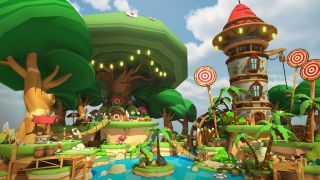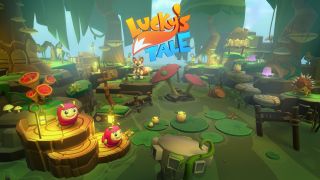Why 3D platformers could be one of virtual reality's best genres

At E3 2014, the Oculus Rift game that captured everyone’s imagination wasn’t a first-person shooter or immersive scare-fest or actiony space sim. It was a platformer: the cute, Mario-inspired Lucky’s Tale. Everyone loved Lucky’s Tale. But it was just a prototype. And after the overwhelmingly positive response, the developers at Playful Corp. had to tackle the task of making a full length 3D platformer for VR. A year after Lucky’s debut, Playful Corp. returned to E3 with a real game, and it’s even better proof that first-person isn’t the only way to make VR gaming work. It might not even be the best way.
“I think over half the games that Oculus is showing at this show are 3rd person,” said CEO Paul Bettner, after I tried out the latest Lucky’s Tale demo at E3 2015. “Last year we were the only one and everyone was giving us strange looks, like, ‘3rd person in VR?’…I do think, as crazy as it seems, that most VR games with character locomotion are going to end up being 3rd person games, where you’re either traversing an environment or moving your character in an environment. And then the the first person style experiences...where you’re sitting at a desk and it’s like this puzzle that comes to you and you do things with it, or stand up and walk around in a small space.”
A year ago, the Lucky’s Tale prototype was unmistakably (and unabashedly) Mario inspired, and playing it recalled taking those first few steps in Mario 64 and being wowed by its 3D world. The prototype level was far more linear and much easier than Mario, but platforming in VR, with its depth and an innate sense of immersion, gave me the same sensation: this is a defining use of new technology. The Lucky’s Tale of 2015 is now a more complete game. In some ways it feels even more like Mario, with linear, but larger, environments, leisurely explorable with collectables scattered about. The camera is now locked closer behind Lucky’s back as you progress forward, and running around the environment made me think of some of Mario Galaxy’s larger levels.
“It’s all about the interplay of the way the camera engine works, which is always to design first and foremost for comfort, and then the ways we can push that to do interesting things with the level design,” said Dan Hurd, the director of Lucky’s Tale. “This level you just played, it’s still linear, but it has a much greater sense of feeling like an open space that you can explore...We’ve had to get really clever about how to create a sensation of an open environment you can explore, even though really you don't ever feel like you need to go back behind you, because that doesn’t work very well. That would require rotating the camera and other things that we’re trying to avoid, to keep it simple and accessible. So, as you saw in this, there’s lots of tricks around teleporting Lucky around and bringing you to different spots in the level, where you still always feel like you know where to go.”
I was surprised just how different Lucky’s Tale felt with a rather small camera change. That first prototype level felt more like I was guiding this small character through a virtual world, while bringing the camera in closer to Lucky made it feel more like I was playing as him, with our perspectives in sync. “I think [when the game] ships next year, it’s probably going to be a unique perspective based on the area of the level you’re in, because it conveys a different feeling,” Bettner said. “When you're really up close to him, you feel more like you’re inside the level, and when you’re further back, you feel more like you’re playing a video game.”
Even tiny changes to camera angle and position have a major impact in VR, and that’s tricky to balance—especially since the field of view has changed from Oculus Rift DK2 to Crescent Bay to consumer model. The camera angle affects how you experience the game, but it also affects motion sickness. I found myself getting just a touch of nausea as the camera moved away from Lucky and I went running laterally along a series of narrow walkways. When the camera was closer behind Lucky and I was moving forwards, my brain handled it just fine.
Bettner and Hurd plan to follow in the footsteps of other 3D platformers by mixing in a variety of minigames and boss fights between traditional levels, with some hard-to-find collectables hidden in those levels. Before starting development on Lucky’s Tale, Playful Corp. prototyped about 40 different game ideas to see what worked (and what didn’t) in VR. Some of those ideas weren’t worth turning into full projects, but Bettner wants to incorporate the ones that worked into Lucky’s Tale as minigames. “The stuff that really ignites our creativity is, OK, how do we complement those traditional kind of levels with new games that feel VR but are also very exciting?” Bettner said.
The biggest gaming news, reviews and hardware deals
Keep up to date with the most important stories and the best deals, as picked by the PC Gamer team.
While Lucky’s Tale controls like a traditional 3D platformer, with typical gamepad controls, Bettner thinks that the new Oculus Touch controller may end up being even more compelling for third-person games than it is for first-person, in the same counterintuitive way Lucky’s Tale proved the efficacy of third-person VR.
“In first person, if everything’s at first person scale, how many things can you actually reach?” he pointed out. “But in the case of Lucky style of games...Lucky’s Tale does all these tricks with scale and other things to bring the world into this sweet spot that is within arm’s reach, because it’s...more compelling in VR when stuff is close. It’s just the way the hardware works and the brain’s wired. Stuff in this range just feels better. So I actually think the application of those controllers in 3rd person type of games, whether it’s something like Lucky’s Tale which we have some really cool ideas for, or an RTS, I mean god games, there are some really cool ideas in the way you can just reach your hands into a little toy and do things with it.”

Bettner is aiming for Lucky’s Tale to be out as an Oculus Rift launch title in early 2016. They want it to be accessible to as many players as possible, but when I made a comparison to Wii Sports—asking whether they hoped Lucky’s Tale could be the game that helps sell people on the concept of VR—Hurd had something else in mind.
“The Wii Sports thing is more like the thing you’re going to show you’re friends and be like, ‘This is why I bought VR to check out this 5 minute experience.’ But it’s not necessarily something that someone goes home and says, ‘Oh I have to buy that because I experienced it.’ And what we’ve been trying to do with [Lucky’s Tale] is actually create a real game that people would sink their teeth into, that you could see yourself playing the second week after you bought it.”
Could a genre that’s been around so long be the best case for VR? I think it’s possible, because the purity and familiarity of the platformer makes underlying changes in technology all the more profound.
“The thing that gets me so excited about it is, I feel that the 3D platformer, the whole genre, has actually come home here,” said Hurd. “We’re not clinging to the blob shadows as much as we used to. I’m using depth perception. I don’t wrangle the camera, so for me it just feels like the most natural fit. We dealt with these abstractions when Mario went 3D because there was so much to be gained from the 3D-ness of it. And now we’re peeling away those elements and it feels even more freeing. It’s like, ‘Yeah, this is actually what we wanted back then, but now it’s happening.’ And it gets me really excited.”

Wes has been covering games and hardware for more than 10 years, first at tech sites like The Wirecutter and Tested before joining the PC Gamer team in 2014. Wes plays a little bit of everything, but he'll always jump at the chance to cover emulation and Japanese games.
When he's not obsessively optimizing and re-optimizing a tangle of conveyor belts in Satisfactory (it's really becoming a problem), he's probably playing a 20-year-old Final Fantasy or some opaque ASCII roguelike. With a focus on writing and editing features, he seeks out personal stories and in-depth histories from the corners of PC gaming and its niche communities. 50% pizza by volume (deep dish, to be specific).
Most Popular


